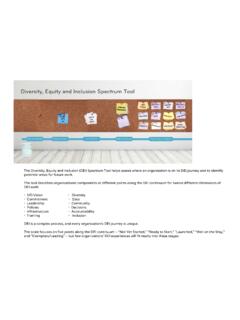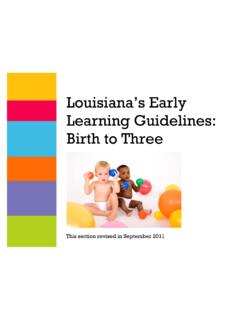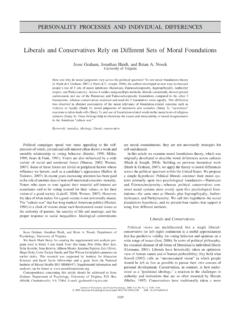Transcription of Values, Attitudes, and Behaviors
1 ObjectivesValuesPersonal ValuesFamily ValuesReality CheckValues Across the LifespanValue Congruence AcrossGenerationsAttitudesBehaviorsValue s, attitudes , and Behaviors inthe Decision-Making FrameworkIn the NewsValues and Behaviors in FamilyPurchasing DecisionsBrand PreferenceQuality PreferencePrice PreferenceDesign PreferenceThe Marketing Profession s Interestin Family ValuesImpact of Culture on Values, attitudes , and BehaviorsWorldviewConsistency Over Time and SituationObjectives Understand the concepts of values, attitudes , andbehaviors and how theyimpact family decision-making. Become familiar with thefactors that impactdevelopment, maintenance,and changing of personal andfamily value sets over time. Become aware of howexternal forces impact valueexpression in theidentification of needs andalternatives and in thedecision-making process.
2 Be able to applyunderstanding of Values, attitudes , and Behaviors tothe critical analysis of familydecisions and Behaviors in , Attitudes, and BehaviorsUnderstanding Family 8/6/2007 8:15 PM Page 99 Not everything that can be counted counts, and not everythingthat counts can be counted. Albert EinsteinIndividuals and families discover, rank, and create evaluative meaningsfor their needs. Every step of the decision-making process is impactedby one s values, attitudes , and Behaviors . When family members are con-templating or discovering needs, they rely on these subjective measures torank order or prioritize the multiple needs. For instance, family membersneed new clothing is required is a function of existingresources and environmental conditions. Beyond that, in American soci-ety, new clothing purchases are motivated primarily by social expectationsand how deeply the family unit is persuaded to follow fashion and socialpressure.
3 A bride needs a wedding dress, right? Well, actually, legal mar-riage ceremonies do not mandate participants dress. If a traditional wed-ding dress is perceived as a real need, it is processed as such. From thatpoint, values and resources are weighed to determine what type of dress isobtained and how it is secured. Will it be borrowed? Purchased? Created?To understand the impact of values, attitudes , and Behaviors on familyresource management, we must understand the definitions of many termsthat are often used is a term used often in the discussion of human behavior from twounique perspectives. When discussing economics and consumer behavior ,the term valueis used as a measurement of exchange. If you spend moneyon goods or services, you expect satisfaction from that exchange of is determined to be a good value if the person exchanging resources feelsthat he or she received a fair return.
4 This determination of fairness is sub-jective. A baseball card collector may feel that one single card is worth sev-eral hundred dollars. Someone who is not involved in this hobby may feelthat such a purchase would be a waste of monetary resources. A grand-mother s collection of photographs may be priceless to one grandchild, butof little perceived value to common use of the term valueis perhaps even more subjectiveand personal in nature. Guiding principles of thought and behavior areoften referred to as one s values. It is believed that these principles developslowly over time as part of the individual s social and psychological devel-opment. Researchers have focused on these dispositions in numerous sci-entific studies in an attempt to measure, predict, and understand howvalues guide thought and FAMILY 8/6/2007 8:15 PM Page 100A search for universal values has been troublesome to theorists.
5 Humanrights are discussed and presented as universal values, yet some of theserights are not embraced by all groups. The practice of female genital muti-lation, or female circumcision, is one such debated violation of humanrights. Boulding (1985), an economist and philosopher, purports thathuman betterment is an appropriate goal for everyone across all culturesand nations. Human betterment, or an increase in the quality of life for all,is reflected in four dimensions: economic adequacy, justice, freedom, values may be difficult to define, but cultural or social valuesare not. When a group of people embrace a set of understood Values, members operate within those beliefs and are judged accordingly. The dis-cussion of worldview in chapter 1 illustrates this the United States, especially in business and educational institutions,punctuality is highly valued.
6 Teachers expect students to be in class whenthat class is scheduled to begin. Not every American accepts that one par-ticular value , but being late is generally unacceptable and carries conse-quences. Being late for a commercial airplane flight may result in the lossof the price of that ticket and the loss of travel via that medium. Being latefor a meeting may result in missed leadership opportunities or, in somecases, unwanted VALUESV alues, when framed within a religious or spiritual framework, areoften referred to as morals. Using morals in decision-making is placingvalue judgments on a continuum of right and wrong. Kohlberg (1984)proposes that humans develop a set of morals as they mature, bothsocially and intellectually (see Table ). One s sense of justice and how heor she makes judgments about what are good and bad decisions evolveover time primarily due to changes in cognitive abilities.
7 Young, school-age children think concretely. Something is always right or always wrong,Values, attitudes , and Behaviors101 LevelPre-conventionalConventionalPost-co nventionalStage1. Obedience and punishment2. Individualism, instrumentalism, and exchange3. Good boy/girl 4. Law and order5. Social contract6. Principled conscienceTable 's Sequence of Moral 8/6/2007 8:15 PM Page 101there are no shades of gray. Adolescents, who are capable of abstract think-ing, will begin to contemplate each situation in terms of context, alterna-tives, and impact of actions on self and others. Some adults, according toKohlberg s sequence, will consider universal moral principles even at therisk of breaking their own civil laws. One example frequently used toexplain this concept is the husband who would break into a pharmacy tosteal a medication that would keep his wife alive, rather than let her diebecause he couldn t pay for this model of moral development assumes a progressionthrough stages, it does not assume that every individual moves througheach and every stage.
8 Thus, any group of adults may have individuals func-tioning at different phases of Kohlberg s model. Obviously, a multigenera-tional family will also have members operating at different levels. Adults infamily units are most often the final decision makers, but that does notmean that family decisions will then reflect the higher moral levels. If thoseadults are functioning at lower levels, decisions will reflect and Mrs. Jones set aside an entire day each February to preparetheir income tax returns. They read the directions carefully and reportboth their earnings and deductions honestly. Mr. and Mrs. Smith waituntil the last day to file taxes. They claim only the income they havereceived that can be traced through federal reporting forms and exag-gerate many deduction amounts to reduce their final tax payment.
9 TheJones are functioning at a moral level that reflects their beliefs in whatis right and what is wrong and their sense of obligation to the govern-ment. The Smiths may feel that the government is misusing funds col-lected through taxation or may rationalize their behavior in other beliefs that are held strongly enough within a group may ultimatelybecome laws with punitive legal consequences. Accurate reporting of infor-mation on tax reports has legal consequences, but only when faced with decisions that impact society, but aren t mandated bylaw, family members responsible for making decisions regarding resourcemanagement must rely on their values, morals, and past experiences toreach decisions that they are comfortable making. One purchase decisionfaced by many families is the procurement of a vehicle for decision has personal, family, and social contemplating the purchase of automobiles in the United States,consumers have many options.
10 The selection includes many sizes, config-urations, materials, and fuel sources. Some vehicles are fuel-efficient,whereas others are gas-guzzlers. Current laws do not impose restrictionson gas mileage of automobiles. A conscientious consumer may forgo somesize capacity and styling options because he or she wants to reduce thepollution and consumption of gasoline. Another may be determined to102 DISCOVERING FAMILY 8/6/2007 8:15 PM Page 102buy larger, less efficient vehicles because he or she needs the size to trans-port others and/or materials. Neither is breaking a law. Both are express-ing their consumer rights. Both may value the need to reduce air pollutionand fossil fuel consumption. The second owner, however, is rationalizinghis or her purchase by prioritizing existing needs (hauling capacity) aboveenvironmental VALUESV alues, attitudes , and Behaviors103 Reality CheckJeremiah was born and raised in a conservative, Catholic community inthe Midwest.

















